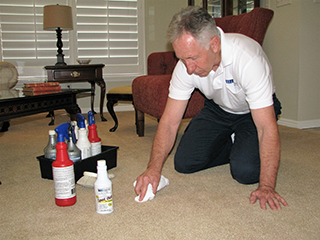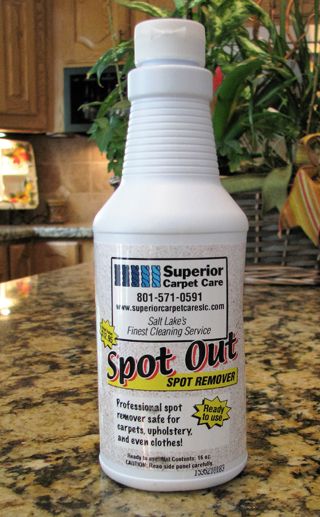Carpet Care Tips

Spots and Spills
A good checklist to handle spills should include the items on the list below. Do not use any household cleaners other than those listed, since many household products contain chemicals that may permanently damage your carpet.
- A solution of a mild liquid detergent (no more than 1/4 teaspoon of detergent to 32 ounces of water). A clear, non-bleach liquid dishwashing detergent such as Dawn, Joy, or clear Ivory is recommended. Do not use detergents that are cloudy or creamy because they may leave a sticky residue.
- A solution of 1 part white vinegar to 1 part water.
- White cloths or white paper towels.
- An ammonia solution of one tablespoon of ammonia to one cup of water. Do not use on wool.
- Non-oily nail polish remover
- Chewing gum remover (freeze or solid type).
- A quality spot remover (see below).

Free Spot Remover
All carpet cleaning services performed by Superior Carpet Care is 100% satisfaction guaranteed, and comes with a free bottle of his professional quality "Spot Out" cleaning solution to help you maintain your beautifully cleaned carpet.
NOTE: Difficult stains on carpets made from solution-dyed fibers such as polypropylene may be removed with a mild bleach solution ( one part chlorine bleach to five parts water).
WARNING: Do not use bleach solution unless you are absolutely certain your carpet is 100% solution dyed. Carpet dyed by other systems will be damaged. If in doubt, call Stan!
General Instructions
- Act Fast! Prompt attention to spots and spills is essential. No carpet is stain proof, although many are stain resistant, which allows time to act.
- Remove as much of food spills as possible by scraping gently with a spoon or dull knife.
- Absorb wet spills as quickly as possible by blotting repeatedly with white paper or cloth towels.
- Always blot, never rub or scrub abrasively, as a fuzzy area may result. When blotting, work from the outer edge in toward the center of the spot to avoid spreading the spill.
- Always follow up with water to remove detergent residue that may become sticky and cause rapid re-soiling.
- Draw out any remaining moisture by placing several layers of white towels over the spot and weigh them down with a heavy object that will not transfer color such as a plastic jug of water.
| STAIN | REMOVAL
PROCEDURE (see below) |
| Alcoholic Beverages | A |
| Asphalt | B, Stan Wynhof |
| Beer | A |
| Betadine | Stan Wynhof |
| Berries | A |
| Blood (wet) | A |
| Blood (dry) | A-2 |
| Butter | B |
| Chewing Gum | C |
| Chocolate | A-2 |
| Coffee | A-1 (D if necessary) |
| Cola Drinks | A |
| Cosmetics | A (D if necessary) |
| Crayon | B |
| De-icer (Calcium Chloride) | Vacuum, A |
| Excrement | A |
| Food Dyes | A |
| Furniture Polish | B, Stan Wynhof |
| Glue (white) | A |
| Gravy | A |
| Grease (Auto) | B, Stan Wynhof |
| Grease (Food) | B |
| Ice Cream | A |
| Ink (Ballpoint) | B, Stan Wynhof |
| Ink (Permanent) | B, (D if necessary) |
| Ink (Washable) | A, Stan Wynhof |
| Jelly | A |
| Lipstick | B |
| Milk | A |
| Mud | A |
| Mustard | A, (D if necessary) |
| Nail Polish | Polish Remover |
| Paint (Latex, wet) | A |
| Paint (Latex, dry) | B |
| Paint (Oil) | B, Stan Wynhof |
| Rust | Stan Wynhof |
| Shoe Polish | B |
| Tea | A. (D if necessary) |
| Urine | A-1, Stan Wynhof |
| Vomit | A-1 |
| Wax | C |
| Wine | A-2 |
Stain Removal Procedures -
Stan Wynhof -- Superior Carpet Care |
More Maintenance Tips
|
||||||||||
|
||||||||||